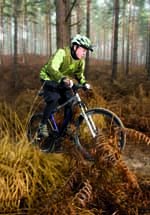 FRAME
FRAME
The primary idea behind Genesis geometry is to move the rider’s centre of gravity rearward, theoretically aiding climbing traction as more weight is placed over the rear tyre’s contact patch. It also reduces the likelihood of going over the bars on descents. Shorter chainstays and a longer front centre is the chosen method. This means that the top tube is longer than on an equivalent-sized frame with standard geometry, requiring a shorter stem.
Both the top and down tubes are externally and internally butted. The larger diameter tubing makes for a larger weld footprint and stiffens up the joints. The smaller diameter tube centres are lighter as they take less stress. Sculpted curves on the chainstays increase tyre clearance and improve ankle clearance. Small cross-section, straight seatstays add minimal weight.
Sadly the bike’s racing pedigree shows through with the head tube: it’s tiny. It does mean the flat-back racer stance is easy to maintain, but normal trail riding needs a good inch and a half of spacers under the stem.
FORK
Only the RockShox Reba SLs on the Focus were lighter than the Manitous fitted here. The Sliver Super Lockouts certainly go some way to explaining the low overall weight, but that’s about all you can say for them. The 28.6mm stanchions flex at the mere sight of a big lump, and the forged crown simply cannot cope with the loads placed on it. Add to that the simple Fluid Flow damping and things get worse, but at least you’re too distracted by the wandering front wheel to notice the lack of stroke control. A lack of compression adjustment further limits the fork.
WHEELS
Bontrager’s Select wheelset is a real highlight on the Fisher. Easily the lightest wheels on test — only the Altitude 1.0’s hoops come close — these save over three-quarters of a pound on every other set. Combine these light wheels with the fastest-rolling, lightest tyres on test and it’s easy to see why the Fisher picked up speed so well. Lighter wheels use less energy to accelerate and slow down than heavier ones, and saving half a pound here is worth more than a couple of pounds of static weight. The Bontrager XR tyres are only really summer sneakers. Sparsely treaded, they slip around in the wet and fail to cope with the power of the Avid Juicy 3s.
COMPONENTS
Bontrager’s Select moniker figures heavily on the finishing kit. It’s all good, serviceable stuff. The flat bar suits the race crowd (like the bike) and it is a full 25in wide. One high point are the Avid discs. Juicy 3s grace three machines in the test and set a new benchmark for performance at this price point. The Shimanos fitted elsewhere come close in terms of power, but none can match the Avids for feel. It’s just a shame the tyres were easily overpowered.
PERFORMANCE
Genesis geometry regularly splits opinion. There’s no doubt it allows you to lay down the power on the flat and climbing. Singletrack on the other hand is another story. Flat out it’s fine, but at slow speeds it feels strange, lacking any fluid feel for direction change. Like the low front end, this is a throwback to the birthplace of the idea: the XC race circuit.
VERDICT
As mentioned, the Hoo Koo E Koo polarises opinion. The low weight of the Fisher will suit those with competitive urges, and the geometry will suit too. Fork performance is less of an issue for racers, but for trail riders it will lessen the experience.
We always recommend a proper test ride, but with this bike it’s imperative. If the layout suits your body shape or riding then the light frame and decent kit can form the basis of a fine relationship. For everyone else, the shonky fork and unusual geometry can hamper a day on the trails. Just don’t discount it straight away — you may be pleasantly surprised.
MBR RATING: 8/10



